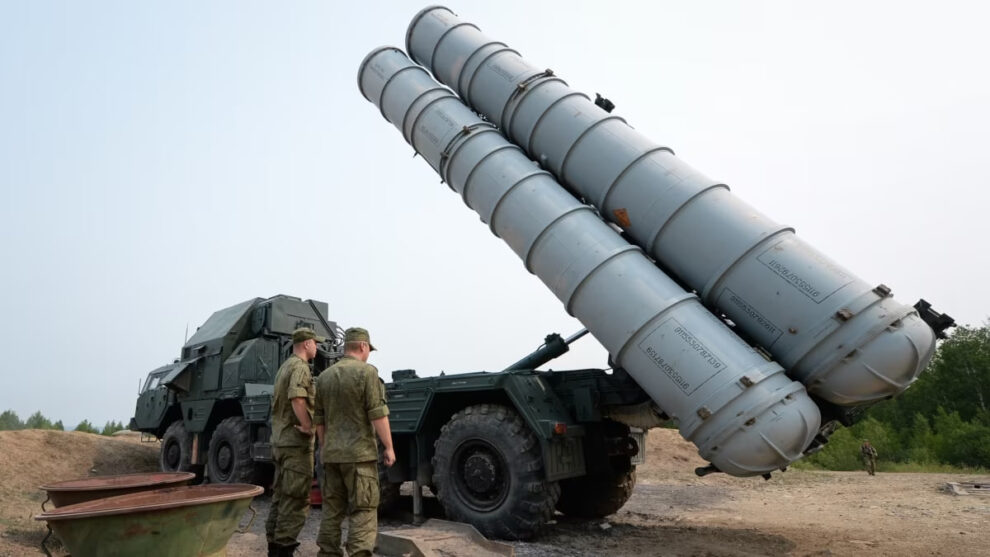At a meeting with members of the Russian government on the evening of November 22, Russian President Vladimir Putin announced another contribution to “the formation of a single, common, united air defense system of the countries of the Collective Security Treaty Organization (CSTO),” with the addition: “We have already carried out a great deal in this regard work.”
We are talking about the deployment of anti-aircraft missile systems (SAM) of the S-300 family in Tajikistan. Such a measure was approved by the country’s President Emomali Rahmon during his two-day official visit to Russia. “We have already delivered two divisions of our S-300 air defense systems to Tajikistan, these are eight launchers,” Putin said.
Addressing the Russian ministers participating in the meeting on November 22, Putin asked them to contribute in every possible way to “the continuation and completion of this work on the CSTO as a whole,” for which the Russian “government must issue a corresponding order by the end of the year – this is a technical issue, but I ask you not to miss it.” kind and bring it to the end.” According to Putin, this topic was covered in detail in his report the day before by Defense Minister Sergei Shoigu (however, the details were not published in the open press. – NVO).
During the conversation between Putin and Rakhmon in the Kremlin, it was stated that relations between our countries are in the nature of alliance and strategic partnership. They are based on the Treaty of Friendship, Cooperation and Mutual Assistance, which entered into force on November 17, 1993. There was an increase in mutual trade turnover to $1.5 billion, and payments in national currencies increased to 82%. More than a million Tajiks work in Russia and, according to Putin, “make a great contribution to the development of the Russian economy.”
Increased attention was noted to the topic of bilateral cooperation in the development of oil and gas fields and the development of mineral deposits. Their number in Tajikistan is about 800. Among the actively developing projects is the search and development of uranium and rare earth metals mines. Prominent among them is lithium, which is known to be increasingly used in ultra-high-capacity batteries, including those on submarines.
The interaction on the issues of joint reclamation of the territories of Tajikistan, where uranium production was located in the past, was assessed positively. Here the main partner of the Tajik side is Rosatom.
The corporation recently completed a project to rehabilitate an industrial uranium processing site. According to Rakhmon, Rosatom remains the “main partner” of the Tajik side in this area.
At meetings in Moscow, Putin and Rakhmon paid special attention to the topic of further development of cooperation in the nuclear field.
The interlocutors also dwelled in detail on issues of interaction within the framework of the Union of Independent States, the Shanghai Cooperation Organization and the United Nations. The problem of security in Central Asia was touched upon in relation to issues that arise in Afghanistan. “We agreed to further deepen defense, military-technical, anti-terrorism, anti-drug cooperation,” Putin said. “In general, we will continue to make efforts to maintain peace and stability in the Central Asian region, for which we intend to continue to actively use the capabilities of the 201st Russian military base stationed in the republic.”
Rakhmon said he views his official visit to Moscow “as an important step towards further expanding the strategic partnership and alliance of our countries” and bringing bilateral interaction to a “qualitatively higher level.” He noted the steady dynamics of development of bilateral relations and spoke in favor of “increasing our interaction… within the framework of international and regional associations,” including the CSTO.
After the completion of Russian-Tajik negotiations in Moscow, Putin and Rakhmon went to Minsk to participate in a session of the CSTO Collective Security Council. At the end of the negotiations in a narrow circle (the presidents of the Russian Federation, Belarus, Kazakhstan, Kyrgyzstan and Tajikistan), a plenary meeting in an expanded format was held on November 23. Opening the event, President of the Republic of Belarus (RB) Alexander Lukashenko said that it actually ends the period of the chairmanship of the Republic of Belarus with the transfer of this role to Kazakhstan in 2024.
For his part, Vladimir Putin noted that in the past year, contacts between the CSTO and “our natural partners” in the Shanghai Cooperation Organization have developed.
Over the past period, the attention of the CSTO participants has been paid to joint efforts to improve collective rapid deployment and operational response forces, aviation and peacekeeping forces. These include the “Interaction”, “Search” and “Echelon” maneuvers in Belarus, as well as the “Indestructible Brotherhood” peacekeeping exercises in Kyrgyzstan.
Through the intelligence services and law enforcement agencies, Operation Mercenary continued, aimed at suppressing recruitment and blocking exit channels for citizens of CSTO member countries to participate in international activities.
Source: NVO NG News















